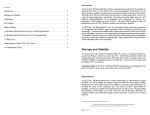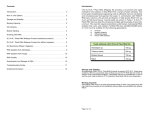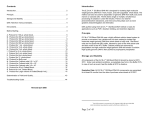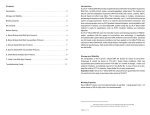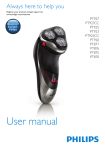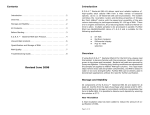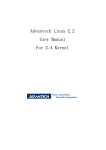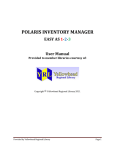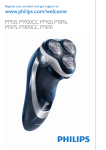Download Contents Introduction Overview Storage and Stability Binding Capacity
Transcript
*Contents Introduction Introduction. . . . . . . . . . . . . . . . . . . . . . . . . . . . . . . . . . . . . . . . . . . . . . . . . . . . . 2 The E.Z.N.A.® Yeast RNA Kit allows convenient isolation of high-quality total RNA from a wide variety of yeast species. Up to 2 x 107 log-phase cultured yeast cells can be processed. The system combines the reversible nucleic acid-binding properties of HiBind® matrix with the speed and versatility of spin column technology to yield approximately 30 ìg of RNA, with an A260/A280 ratio of 1.7-1.9. Purified RNA is suitable for downstream applications such as RT-PCR, DD-PCR, and hybridization techniques. There are no organic extractions, thus reducing plastic waste and hands-on time to allow multiple samples to be processed in parallel. Overview.. . . . . . . . . . . . . . . . . . . . . . . . . . . . . . . . . . . . . . . . . . . . . . . . . . . . . . 2 Storage and Stability.. . . . . . . . . . . . . . . . . . . . . . . . . . . . . . . . . . . . . . . . . . . . . 2 Binding Capacity.. . . . . . . . . . . . . . . . . . . . . . . . . . . . . . . . . . . . . . . . . . . . . . . . 2 Kit Contents. . . . . . . . . . . . . . . . . . . . . . . . . . . . . . . . . . . . . . . . . . . . . . . . . . . . 3 Before Starting. . . . . . . . . . . . . . . . . . . . . . . . . . . . . . . . . . . . . . . . . . . . . . . . . . 4 E.Z.N.A.® Yeast RNA Kit Spin Protocol. . . . . . . . . . . . . . . . . . . . . . . . . . . . . . . 5 Quantitation and Storage of RNA. . . . . . . . . . . . . . . . . . . . . . . . . . . . . . . . . . . . 7 RNA Quality. . . . . . . . . . . . . . . . . . . . . . . . . . . . . . . . . . . . . . . . . . . . . . . . . . . . 7 Troubleshooting Guide. . . . . . . . . . . . . . . . . . . . . . . . . . . . . . . . . . . . . . . . . . . . 8 Overview If working with RNA for the first time, please read this booklet to become familiar with the procedure. Yeast cells are grown to log-phase and spheroblasts are subsequently prepared using Buffer SE and lyticase. Following lysis, binding conditions are adjusted and the sample is applied to a HiBind® RNA spin-column. Two rapid wash steps remove trace salt and protein contaminants, and RNA is eluted in DEPC-treated water. Purified RNA can be directly used in downstream applications without need for further purification. Storage and Stability All components of the E.Z.N.A.® Yeast RNA Kit are stable for at least 24 months from the date of purchase when stored at 22oC-25o C. During shipment or storage in cool ambient conditions, precipitates may form in Buffer YRL. These precipitates should be dissolved by warming the solution at 37o C and gently shaking its container. Binding Capacity Each HiBind RNA Mini Column can bind up to 100 ug Total RNA. Use no more than 3 ml log-phase yeast culture is not recommended. P age 1 of 8 P age 2 of 8 Kit Contents Product Number R6870-00 R6870-01 R6870-02 Purification times 5 Preps 50 Preps 200 Preps 5 50 200 15 150 600 250mg 2.5 g 10 g 15 ml 120 ml 2 x 210 ml Buffer YRL 5 ml 20 ml 80 ml RNA Wash Buffer I 5 ml 50 ml 3 x 70 ml RNA Wash Buffer II 2 ml 12 ml 4 x 12 ml 500 units 5000 units 4 x 5000 DEPC-water 1 ml 10 ml 40 ml User Manual 1 1 1 ® HiBind RNA Mini column 2 ml Collection Tubes Glass Beads Buffer SE Lyticase ! Whenever working with RNA, always wear latex gloves to minimize RNase contamination. Use only clean, RNase-free disposable plastic pipette tips when using the supplied reagents. ! During the procedure work carefully but quickly. ! Under cool ambient conditions, crystals may form in Buffer YRL. This is normal and the bottle should be warmed to redissolve the salt. ! 2-mercaptoethanol (ß-mercaptoethanol) is key in denaturing RNases and must be added to an aliquot of Buffer YRL before use. Add 20 ìl of 2-mercaptoethanol per 1 ml of Buffer YRL. This mixture can be stored for 1 month at room temperature. ! Prepare Buffer SE/Lyticase Mixture: B uffer YR L contains a chaotropic salt. Use gloves and protective eye-wear when handling this solution. ! R6870-00 Dissolve vial of lyticase in 10 ml SE Buffer and add 10ìl of 2-mercaptoethanol per 1 ml of Buffer SE R6870-01 Dissolve vial of lyticase in 100 ml SE Buffer and add 10ìl of 2-mercaptoethanol per 1 ml of Buffer SE R6870-02 Dissolve vial of lyticase in 400 ml SE Buffer and add 10ìl of 2-mercaptoethanol per 1 ml of Buffer SE RNA Wash Buffer II is supplied as a concentrate and must be diluted with absolute ethanol as follows and stored at room temperature. Materials to Be Provided by User R6870-00 Add 8 ml absolute (96%-100%) ethanol ! Microcentrifuge and nuclease-free 2.0 and 1.5 ml tubes. R6870-01 Add 48 ml absolute (96%-100%) ethanol ! Swinging-bucket centrifuge and sterile 15 ml tubes. R6870-02 Add 48 ml absolute (96%-100%) ethanol to each bottle ! Waterbath equilibrated to 30oC. ! 70% ethanol - do not use other alcohols. ! Absolute ethanol (96-100%) ! 2-Mercaptoethanol E.Z.N.A.TM Yeast RNA Kit Spin Protocol Before Starting Page 3 of 8 P age 4 of 8 Since HiBind® RNA resin and spin-column technology actually removes most DNA without the DNase treatment, this DNase I digestion step is not necessary for most downstream applications. However, certain sensitive RNA applications might require further DNA removal. (See DNase I, Cat # E1091 for detailed information.) This protocol uses enzymatic lysis to prepare spheroblasts. Have the following reagents and supplies ready: While the HiBind® RNA mini columns can bind up to 100 ìg RNA, for effective purification, use no more than 2 x 107 log-phase yeast cells. For S cerevisiae grown in YPD, an OD600 of 1.0 corresponds to approximately 2 x 107 cells per ml. 1. 2. 3. a. Wash the column by adding 300ìl of RNA Wash Buffer I to the column. Centrifuge at 10,000 x g for 30-60 seconds at room temperature. Discard the flow-through and re-use the collection tube. Collect no more than 2 x 107 yeast cells in a 15 ml tube by centrifuging for 5 min at 1000 x g at 4oc. NOTE: Use only freshly harvested cells for preparation of spheroblasts. b. For each HiBind® RNA column, have the following DNase I digestion reaction mixture prepared in advance as follows: Aspirate and discard supernatant completely and resuspend cells in 2.0 ml Buffer SE /Lyticase mixture. Incubate at 30oC for 30 min, inverting the tube once every 10 min. Pellet spheroblasts by centrifuging 5 min at 400 x g at room temperature. Carefully aspirate and discard supernatant. Incomplete removal of supernatant will prevent complete lysis of spheroblasts in the next step. 4. Add 350 ìl of Buffer YRL/2-mercaptoethanol and 50 mg glass beads into the tube. Vortex at maxi speed for 5 minutes to lyse and homogenize the sample. If bead mill is available, lyse the cell with bead mill at top speed until the cells are completely lysed. 5. Centrifuge at 13,000 x g for 3 min. Transfer the supernatant into a new centrifuge tube. 6. Add an equal volume 70% ethanol to the lysate and mix thoroughly by pipetting. A white precipitate may form upon addition of ethanol; it will not interfere with the procedure. Do not centrifuge the tube. 7. Apply the entire sample (around 700 ìl) to a HiBind® RNA Mini column assembled in a 2 ml collection tube (supplied). Centrifuge at $10,000 x g for 3060 seconds at room temperature. Discard flow-through and re-use collection tube in Step 8 or Step 9. 9. Wash the sample by adding 700ìl of RNA Wash Buffer I to the column. Centrifuge at 10,000 x g for 30-60 seconds at room temperature. Discard the flow-through and re-use the collection tube. DNase I Digestion (Optional) 73.5 ìl RNase-free DNase I (20 Kunitz unites/ìl) 1.5 ìl Total volume 75 ìl Note: 1. DNase I is very sensitive, and is thus subject to physical denaturation, so do not vortex this DNase I mixture. Mix gently by inverting the tube. Prepare the fresh DNase I digestion mixture before RNA isolation. 2. OBI DNase I digestion buffer is supplied with the OBI RNase-free DNase set. 3. Standard DNase buffers may not be compatible with the Omega BioTek Kit for on-membrane DNase digestion. c. Dry column by spinning an additional 30 seconds, then pipet 75 ìl of the DNase I digestion reaction mixture directly onto the surface of the HiBind® RNA membrane in each column. Make sure to pipet the DNase I digestion mixture directly onto the membrane. DNase I digestion might not be complete if some of the mixture sticks to the wall or to the O-ring of the HiBind® RNA column. d. Incubate at room temperature(25-30NC) for 15 minutes. Note: This is the point at which optional on-membrane DNase I digestion should begin. If DNase I digestion is desired, skip Step 8 and proceed to Step 9. If DNase I digestion is not needed, proceed with Step 8. 8. OBI DNase I Digestion Buffer d. Place column in a clean 2 ml collection tube and add 400 ìl RNA Wash e Buffer I. Allow wash buffer to soak column for at least 5 minutes before proceeding. Centrifuge at 10,000 x g for 15 seconds at room temperature. Discard flow-through and re-use the collection tube in next step. 10. Place column in the same 2 ml collection tube, and add 500 ìl RNA Wash Buffer II diluted with ethanol. Centrifuge at 10,000 x g for 30-60 seconds and discard flow-through. Re-use the collection tube in next step. Note: RNA Wash Buffer II Concentrate must be diluted with absolute ethanol Page 5 of 8 P age 6 of 8 before use. Refer to Page 4 or to label on bottle for directions. 11. 12. Wash sample with a second 500 ìl of RNA Wash Buffer II and centrifuge and discard flow-through as in preceding step. Using the same collection tube, centrifuge the spin cartridge at 10,000 x g for 2 min at full speed to completely dry the HiBind® matrix. Elution of RNA. Transfer the column to a clean 1.5 ml microfuge tube (not supplied with kit) and elute the RNA with 30-50 ìl of DEPC-treated water (supplied with kit). Make sure to add water directly onto column matrix. Centrifuge 1 min at maximum speed. A second elution may be necessary if the expected yield of RNA is greater than 50 ìg. Alternatively, RNA may be eluted with a greater volume of water. While additional elutions increase total RNA yield, the concentration will be lowered since more than 80% of RNA is recovered with the first elution. Pre-heating the water to 70oC before adding to column and incubating column 5 min at room temperature before centrifugation may increase yields. Problem Cause Suggestion Little or no RNA eluted RNA remains on the column ! ! ! Clogged column Column is overloaded ! Reduce quantity of starting material. Incomplete spheroblasting ! ! Extend incubation with Lyticase. Increase Lyticase to 100 units per 107 cells. Reduce amount of starting material ! Degraded RNA Source ! ! ! Quantitation and Storage of RNA RNase contamination To determine the concentration and purity of RNA, measure absorbance at 260 nm and 280 nm in a spectrophotometer. 1 O.D. unit measured at 260 nm corresponds to 40 ìg of RNA per ml. DEPC-water is slightly acidic and can dramatically lower absorbance values. We suggest that you dilute the sample in a buffered solution (TE) for spectrophotometric analysis. The ratio of A260/A280 of pure nucleic acids is 2.0, while for pure protein it is approximately 0.6. A ratio of 1.8-2.0 corresponds to 90%100% pure nucleic acid. Store RNA samples at -70oC in water. Under such conditions RNA prepared with the E.Z.N.A.® system is stable for more than a year. Salt carry-over during elution ! Low Abs ratios It is highly recommended that RNA quality be determined prior to all analyses. The quality of RNA can best be assessed by denaturing agarose gel electrophoresis and ethidium bromide staining. Two sharp bands should appear on the gel. These are the 28S and 18S ribosomal RNA bands. If these band smear towards lower molecular weight RNAs, then the RNA has undergone major degradation during preparation, handling, or storage. Troubleshooting Guide Page 7 of 8 ! ! DNA contamination RNA Quality ! ! Problem in downstream applications P age 8 of 8 Repeat elution. Pre-heat DEPC-water to 70 o C prior to elution. Incubate column for 5 min with water prior to centrifugation. RNA diluted in acidic buffer or DEPC-water Use only freshly harvested cells. Do not store cells prior to extraction unless they are lysed with Buffer YRL first. Follow protocol closely, and work quickly. Ensure not to introduce RNase during the procedure. Check buffers for RNase contamination. Ensure Wash Buffer II Concentrate has been diluted with 4 volumes of 100% ethanol as indicated on bottle. Wash Buffer II must be stored and used at room temperature. Repeat wash with Wash Buffer II. ! Performthe optional DNase I digestion step or Digest with RNase-free DNase after elution and inactivate at 75oC for 5 min. ! DEPC-treated water is acidic and can dramatically lower Abs260 values. Use TE buffer at pH 8.0 to dilute RNA prior to spectrophotometric analysis.





